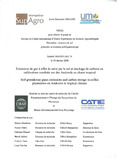Emissions de gaz à effet de serre par le sol et stockage de carbone en caféiculture conduite sur des Andosols en climat tropical

View/
Date
2008Author
Hergoualc'h, Kristell
Autor Corporativo
Université de Montpellier, Montpellier (Francia) (UM)
CATIE - Centro Agronómico Tropical de Investigación y Enseñanza
Type
Tesis de doctorado
Metadata
Show full item recordAlternative title
Soil greenhouse gases emmssions and carbon storage in coffee plantations on Andosols in tropical climate
Description
Tesis (Doctorado) - Université de Montpellier, Montpellier (Francia), 2008
Abstract
Coffee plantations represent 7.5% of the world’s permanent crops and generally use large amounts of N fertilizer (up to 350 kg N ha-1 y-1). Coffee is often grown under the shade of N fixing trees. The contribution of N fixing plants to N2O emissions is a growing concern in the sustainable development framework. To date results in the literature are contradictory. We, therefore, studied the greenhouse gas (GHG) balance in two highly fertilized (250 kg N ha-1 y-1) coffee plantations, in Costa Rica: a monoculture and a plantation shaded by the N2 fixing legume species Inga densiflora. We periodically measured soil fluxes of N2O, CH4 and CO2, their edaphic determinants (gravimetric moisture, water filled pore space, temperature and mineral nitrogen content) and soil N mineralization rates. In addition, we characterized, in the laboratory, the biological parameters of nitrification denitrification and their related N2O and N2 production in order to simulate continuous N2O emissions using the models NGAS and NOE for a one year period. We also assessed soil C dynamic and C accumulation in biomass and litter. Our measurements showed a very large contribution of fertilizer induced N2O emissions, on average 77%, to the annual budgets (4.3 ¦ 0.3 and 5.8 ¦ 0.5 kg N2O-N ha-1 y-1, in the monoculture and the shaded plantation, respectively). The fertilizations also temporarily increased soil respiration rates. The low values of the biological activities (notably denitrification potentials < 1 kg N ha-1 d-1) explained that the observed N2O fluxes were always smaller than 300 g N ha-1 d-1 in environmental conditions yet favourable to N2O production (high soil temperature, moisture and nitrate content). The similarity of the biological activities measured in both coffee plantations and also the similar annual N2O budgets derived through measurements and modelling suggests only a small magnitude effect of the N2 fixing legume tree species on N2O emissions. The sum of soil non CO2 GHG fluxes and C storage in the shaded culture (11.93 ¦ 2.17 Mg CO2-equivalent ha-1 y-1) was 4 times larger than the total GHG balance in the monoculture (2.67 ¦ 1.94 Mg CO2-equivalent ha-1 y-1). Our results therefore confirm that coffee grown in an agroforestry system, on an Andosol, increases the GHG sink and that, for the current context, the use of an N2 fixing legume species as shade tree does not contradict this observation.
Keywords
Asesor
Ganry, F.
Publisher
Université de Montpellier, Montpellier (Francia)
URI (Permanet link to cite or share this item)
https://repositorio.catie.ac.cr/handle/11554/9225Collections
- Tesis [3111]

